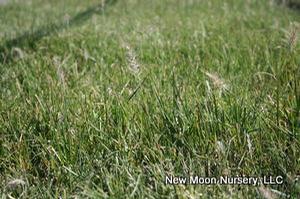Printed at http://www.newmoonnursery.com/index.cfm/
Pennisetum alopecuroides 'Hameln'
Dwarf fountain grass
Native to China (cultivar)
FIRST IMPRESSIONS: Pennisetum alopecuroides ‘Hameln’ is a uniform compact cultivar of Asian fountain grass. ‘Hameln’ has attractive deep green arching linear leaves. In late summer culms are tipped with silvery bottlebrush like flowers. The flowers arch from the clump giving the plant a fountain-like appearance. Plants develop bronzy fall foliage before assuming a soft beige winter color. ‘Hameln’ thrives in sunny exposures with moist well drained soils.
HABITAT & HARDINESS: The parent species Pennisetum alopecuroides is indigenous to grasslands, open woods, wastelands and wetlands of Eastern Asia and possibly Western Australia.
‘Hameln’ is the oldest Pennisetum alopecuroides cultivar. The variety may have had a German origin since it is named for the Pied Piper’s Hamelin, Germany. This selection is known for its compact habit, consistent hardiness and floriferous nature. ‘Hameln’ is said to have deeper green leaves and to bloom about 2 weeks earlier than the species.
Pennisetum alopecuroides ‘Hameln’ is hardy from USDA Zones 6-8. This cultivar is reportedly not as cold hardy or heat tolerant as the species.
PLANT DESCRIPTION: Pennisetum alopecuroides ‘Hameln’ is a diminutive mounding grass that produces many vertical culms from short rhizomes.
Blades are narrow and sharply pointed with a deep green color that transforms to orange or bronze in autumn.
In late summer as the foliage reaches mature height, creamy spike-like panicles appear. The panicles have a dense bristly bottlebrush form. They are silvery with yellow pollen and are produced about two weeks earlier than those of the parent species.
At maturity each spikelet contains one almond colored grain. The dried bristly flowers and foliage have a soft beige winter color. In warm climates, however, foliage is evergreen.
Plants attain a 2’ height with an equal spread.
CULTURAL & MAINTENANCE NEEDS: Pennisetum alopecuroides ‘Hameln’ prospers in sunny sites with average to moist soil. Plants tolerate part sun, clay, heat, drought, salinity and seasonal flooding.
Avoid excessive shade, fertilizers or water as these conditions promote weak sprawling stems. In northern zones, plants should be sited in protected areas.
Winter seedheads contribute little ornamental value since they usually shatter and disperse early in the season. Since self-seeding can be a problem, plants should be deadheaded in autumn before seed mature.
In most cases, the only other maintenance needed is to cut this grass to the ground in late winter.
Plants are relatively pest free but young foliage may be grazed by livestock, deer and other herbivores.
LANDSCAPE USES: This grass is an appealing Accent, Mass Planting, Border or Groundcover that provides Erosion Control, Fall Color, Winter Interest, Cut Flowers, and Attractive Blooms. Pennisetum alopecuroides ‘Hameln’ is appropriate for Containers, Coastal Gardens, Cottage Gardens, Low Maintenance Plantings, Water Wise Landscapes, Rain Gardens, Edges of Water Gardens and Perennial Borders.
COMPANION & UNDERSTUDY PLANTS: Try pairing Pennisetum alopecuroides ‘Hameln’ with Aster novae-angliae ‘Purple Dome’, Echinacea purpurea, Nepeta ‘Walker’s Low’, Liatris spicata or Rudbeckia fulgida ‘Goldsturm’.
Pennisetum alopecuroides ‘Little Bunny’ offers similar appearance and cultural needs. ‘Little Bunny’ is much shorter (to 1’), however. Sporobolus heterolepis could provide similar foliage texture and growth habit for a native plant garden.
TRIVIA: In 2000 'Hameln' received the Michigan Nursery and Landscape Association Growers Choice Award.
Height:
1-2 ftSpread:
1-2 ftSpacing:
3 ftUSDA Hardiness Zone:
6-8Bloom Color:
Pink, WhitePennisetum alopecuroides 'Hameln' Characteristics
Attracts Wildlife
- Songbirds
Attributes
- Ground Cover
- Rain Garden
- Dried Flower
- Cut Flower
Exposure
- Full Sun to Partial Shade
Flowering Months
- October
- September
- August
Foliage Color
- Green
Grass Season
- Warm Season Grass
Growth Rate
- Medium
Salt Tolerance
- Medium
Season of Interest (Foliage)
- Summer
- Spring
- Winter
- Fall
Soil Moisture Preference
- Moist to Wet

